THE DOGRUN
a place to share ideas
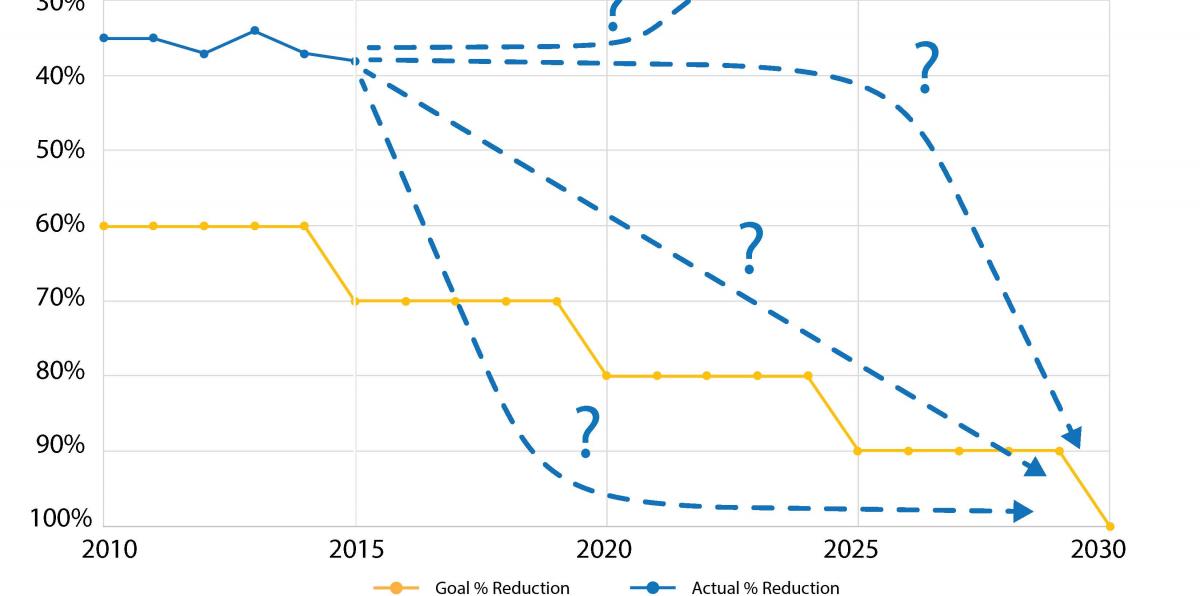

The 2030 End Game
Posted by coreysquire on 2/22/17 at 5:54 pm
With the 7th year of reporting for the 2030 commitment underway, it's worthwhile to pause and think about how the next 13 years might play out. Reporting for the commitment started back in 2011 with a goal of achieving an across the board net-zero energy portfolio by 2030. Initially, the energy reduction target was set at 60% and every five years, the target shifts down 10% until 100% energy reduction is achieved in year 2030.
So far, the actual reductions reported by committed firms have not matched the ambition of the original goals. Since 2011, the aggregate reduction of all reporting firms has hovered around 36% with no clear trend indicating future improvement. This is not to say that a 36% reduction in energy is meaningless, it's a significant achievement, but it's not 70% and it's not a major step towards net-zero. In fact, a 36% reduction is just a little better than the expected 25% reduction from following IECC 2012 (International Energy Conservation Code) and a little worse that the expected 40% reduction from IECC 2015. Six years in, the 2030 is at a crossroads. Are we on the the verge of an energy reduction breakthrough, or is there some sort of deep structure preventing the industry from moving beyond the upper thirties?
Let’s assume that we do achieve across the board net-zero energy buildings by year 2030. What are the scenarios by which this happens? Below are four hypothetical case studies on how the 2030 commitment might be realized. Exploring these possibilities might help us focus our current efforts and shift our trajectory towards the eventual goal.
Design: Incremental Improvement
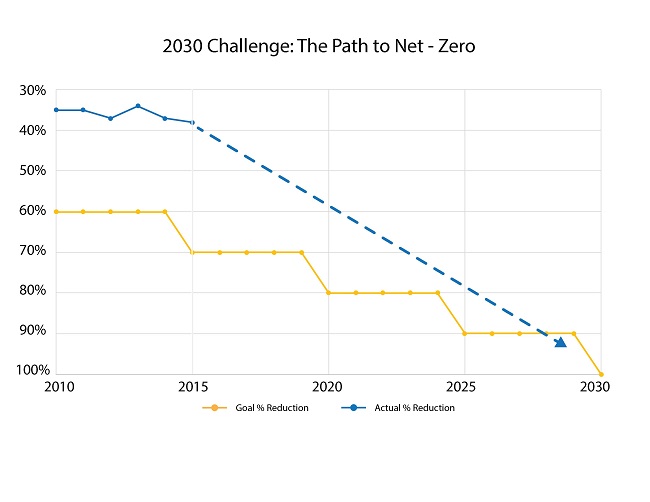 After five years of flat lining on the 2030 energy targets, things suddenly begin to move. The aggregate reported reduction for 2016 is 42%, followed by 46% in 2017 and 53% in 2018. By 2020, when the target shifts to 80%, firms are reporting reductions in the mid-60s and by 2025, net zero starts to feel like an achievable goal. Each year after 2016, firms get a little better at sustainable design and at selling these design to clients. High quality envelopes, daylighting strategies, and efficient mechanical systems start to become the norm rather than the exception. All firms are using early energy modeling to design highly tuned massings and overhangs are getting optimized to the millimeter. Trombe walls, roof ponds, and ground tubes become widely used strategies making buildings even more efficient, and by 2020, thermal bridges are joked about as being “soo twentyteens”. As designers begin to run up against the physical limits of efficiency, energy generation is incorporated to offset the last few kilowatt hours that remain.
Market Forces: Cheap Solar
After five years of flat lining on the 2030 energy targets, things suddenly begin to move. The aggregate reported reduction for 2016 is 42%, followed by 46% in 2017 and 53% in 2018. By 2020, when the target shifts to 80%, firms are reporting reductions in the mid-60s and by 2025, net zero starts to feel like an achievable goal. Each year after 2016, firms get a little better at sustainable design and at selling these design to clients. High quality envelopes, daylighting strategies, and efficient mechanical systems start to become the norm rather than the exception. All firms are using early energy modeling to design highly tuned massings and overhangs are getting optimized to the millimeter. Trombe walls, roof ponds, and ground tubes become widely used strategies making buildings even more efficient, and by 2020, thermal bridges are joked about as being “soo twentyteens”. As designers begin to run up against the physical limits of efficiency, energy generation is incorporated to offset the last few kilowatt hours that remain.
Market Forces: Cheap Solar
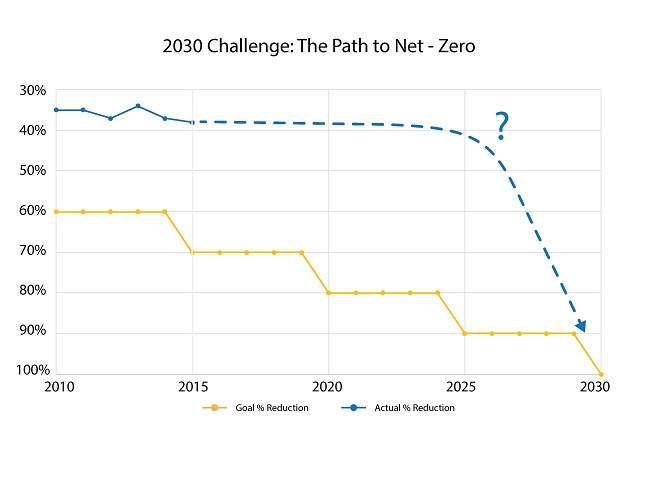 In 2025, the aggregate portfolio energy reductions has remained basically unchanged since it was first reported in 2011. With just five years to go and a reduction target of 90%, the industry is demoralized from working hard towards energy reduction with little client interest and almost no progress to show for it. Most firms have stopped reporting and have basically given up on the commitment in favor of a refocus on materials and health. Then, In 2026, a breakthrough in solar panel manufacturing and distribution brings the installed cost of PV down to $0.25/W with predictions of even lower prices in the near future. With newly abundant cheap solar, firms report a 70% reduction in 2027 and then reach 101% in 2028. That year, almost all firms commit or recommit to 2030 and the AIA celebrates achieving the goal two years early. By 2030, net-zero buildings are far cheaper to build and operate than conventional buildings due to near limitless cheap solar energy and the major focus on building efficiency over the past two decades seems foolish in retrospect. There are a few widely reported cases of building owners with north-facing roofs or gas systems completed circa 2025 winning malpractice suits against architects for not anticipating the coming age of solar and providing aggressive solar-ready design.
Cultural Paradigm: Environmental Epiphany
In 2025, the aggregate portfolio energy reductions has remained basically unchanged since it was first reported in 2011. With just five years to go and a reduction target of 90%, the industry is demoralized from working hard towards energy reduction with little client interest and almost no progress to show for it. Most firms have stopped reporting and have basically given up on the commitment in favor of a refocus on materials and health. Then, In 2026, a breakthrough in solar panel manufacturing and distribution brings the installed cost of PV down to $0.25/W with predictions of even lower prices in the near future. With newly abundant cheap solar, firms report a 70% reduction in 2027 and then reach 101% in 2028. That year, almost all firms commit or recommit to 2030 and the AIA celebrates achieving the goal two years early. By 2030, net-zero buildings are far cheaper to build and operate than conventional buildings due to near limitless cheap solar energy and the major focus on building efficiency over the past two decades seems foolish in retrospect. There are a few widely reported cases of building owners with north-facing roofs or gas systems completed circa 2025 winning malpractice suits against architects for not anticipating the coming age of solar and providing aggressive solar-ready design.
Cultural Paradigm: Environmental Epiphany
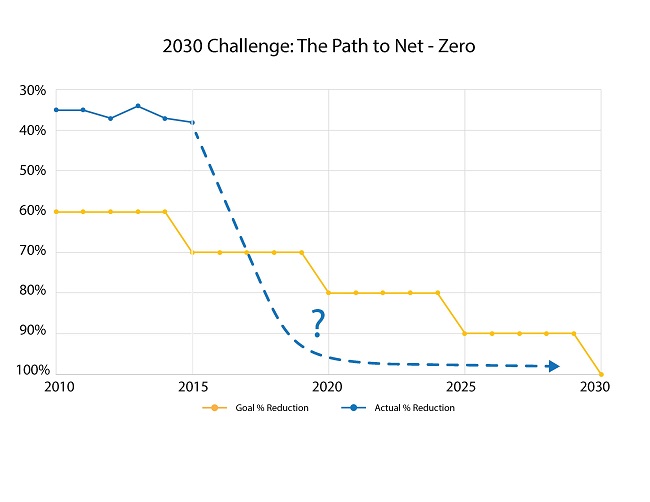 In 2018, a series of Category 5 hurricanes strikes the US eastern seaboard with devastating consequences. In the aftermath, the media focuses on how carbon emissions are changing the atmosphere and creating stronger storms, and the public begins to take notice. Unlike the momentary focus on climate change that followed hurricane Katrina, this time a sense of shared responsibility settles in and changes in behavior begin to shake the trend of increasing global carbon emissions. A poll conducted in early 2019 shows that a record 95% of Americans believe that climate change is a major problem and 93% believe it's caused by humans. As this new awareness settles in, Architects see a major shift in their client’s values towards widespread sustainability. Where previously a 10 year payback would be unthinkable, most clients will accept a 20 year payback for a system with significant energy reduction. Instead of cutting out efficiency measures, value engineering begins to focus on cutting scope or interior finishes. The change in paradigm is so profound that most clients want their building to be net-zero as their number one goal, with square footage and cost all depending on what's possible from an energy perspective. Year after year, the aggregate energy reduction increases and in 2027, when it seems that we would just miss net-zero by 2030, many clients are more than happy to sacrifice further and ensure that the goal was met.
Big Government: Net-Zero Energy Codes
In 2018, a series of Category 5 hurricanes strikes the US eastern seaboard with devastating consequences. In the aftermath, the media focuses on how carbon emissions are changing the atmosphere and creating stronger storms, and the public begins to take notice. Unlike the momentary focus on climate change that followed hurricane Katrina, this time a sense of shared responsibility settles in and changes in behavior begin to shake the trend of increasing global carbon emissions. A poll conducted in early 2019 shows that a record 95% of Americans believe that climate change is a major problem and 93% believe it's caused by humans. As this new awareness settles in, Architects see a major shift in their client’s values towards widespread sustainability. Where previously a 10 year payback would be unthinkable, most clients will accept a 20 year payback for a system with significant energy reduction. Instead of cutting out efficiency measures, value engineering begins to focus on cutting scope or interior finishes. The change in paradigm is so profound that most clients want their building to be net-zero as their number one goal, with square footage and cost all depending on what's possible from an energy perspective. Year after year, the aggregate energy reduction increases and in 2027, when it seems that we would just miss net-zero by 2030, many clients are more than happy to sacrifice further and ensure that the goal was met.
Big Government: Net-Zero Energy Codes
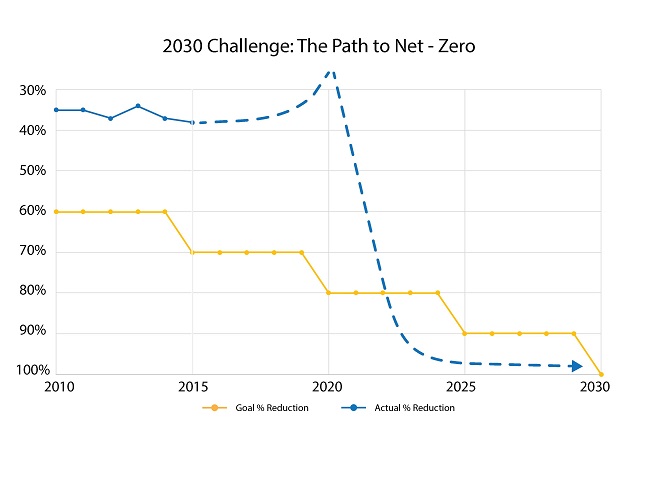 Despite a brief period of time in 2018 when energy codes were outlawed across the nation, government regulations have been largely responsible for achieving the global carbon neutrality that we currently enjoy. The 2020 presidential election restores not only liberal democracy to the United States, but also a commitment to global sustainability. In 2022, just two years after the target shifts to 80%, the 2030 commitment is adopted as federal energy code. As before, individual states are welcome to adopt more stringent requirements, and many do, including California whose “Title 2028” shifts the goal up two years. Initially it is difficult for projects to comply, but a program of government building energy grants helps building owners afford systems that will help meet the goal. By 2030, with building carbon emissions solved, the government turns its attention to its next challenge: the eradication of global poverty by 2035.
Breaking through the structure
Each of these scenarios presents a different structure that is preventing the industry from moving forward with more robust energy reductions, and a thought on how these structures might be overcome. Have reductions stagnated because we've run up against the limits of effort, technology, culture, politics, or some other force that we haven't recognized?
Looking at these options, it seems unlikely that across the board net-zero energy will be achieved just by trying harder or by some drastic altruistic shift in cultural values. This leaves policy or technology as the most likely paths to 2030. Accepting this premise, what can we do today to set up the industry to achieve net zero over the next decade? What if we were to spend less time building energy models and more time advocating for regulation? Would this be a more effective strategy for achieving our goals? Whether advances in solar energy happen gradually or all of a sudden, solar will become a larger piece of the net-zero equation. Does it make sense to prioritize solar ready design over improvements in energy efficiency?
The next few years of reporting might show a downward shift in energy, but if the reports show reductions that continue to stagnate, the onus will be on us to determine what is blocking our progress and to change our approach.
Despite a brief period of time in 2018 when energy codes were outlawed across the nation, government regulations have been largely responsible for achieving the global carbon neutrality that we currently enjoy. The 2020 presidential election restores not only liberal democracy to the United States, but also a commitment to global sustainability. In 2022, just two years after the target shifts to 80%, the 2030 commitment is adopted as federal energy code. As before, individual states are welcome to adopt more stringent requirements, and many do, including California whose “Title 2028” shifts the goal up two years. Initially it is difficult for projects to comply, but a program of government building energy grants helps building owners afford systems that will help meet the goal. By 2030, with building carbon emissions solved, the government turns its attention to its next challenge: the eradication of global poverty by 2035.
Breaking through the structure
Each of these scenarios presents a different structure that is preventing the industry from moving forward with more robust energy reductions, and a thought on how these structures might be overcome. Have reductions stagnated because we've run up against the limits of effort, technology, culture, politics, or some other force that we haven't recognized?
Looking at these options, it seems unlikely that across the board net-zero energy will be achieved just by trying harder or by some drastic altruistic shift in cultural values. This leaves policy or technology as the most likely paths to 2030. Accepting this premise, what can we do today to set up the industry to achieve net zero over the next decade? What if we were to spend less time building energy models and more time advocating for regulation? Would this be a more effective strategy for achieving our goals? Whether advances in solar energy happen gradually or all of a sudden, solar will become a larger piece of the net-zero equation. Does it make sense to prioritize solar ready design over improvements in energy efficiency?
The next few years of reporting might show a downward shift in energy, but if the reports show reductions that continue to stagnate, the onus will be on us to determine what is blocking our progress and to change our approach.
 After five years of flat lining on the 2030 energy targets, things suddenly begin to move. The aggregate reported reduction for 2016 is 42%, followed by 46% in 2017 and 53% in 2018. By 2020, when the target shifts to 80%, firms are reporting reductions in the mid-60s and by 2025, net zero starts to feel like an achievable goal. Each year after 2016, firms get a little better at sustainable design and at selling these design to clients. High quality envelopes, daylighting strategies, and efficient mechanical systems start to become the norm rather than the exception. All firms are using early energy modeling to design highly tuned massings and overhangs are getting optimized to the millimeter. Trombe walls, roof ponds, and ground tubes become widely used strategies making buildings even more efficient, and by 2020, thermal bridges are joked about as being “soo twentyteens”. As designers begin to run up against the physical limits of efficiency, energy generation is incorporated to offset the last few kilowatt hours that remain.
Market Forces: Cheap Solar
After five years of flat lining on the 2030 energy targets, things suddenly begin to move. The aggregate reported reduction for 2016 is 42%, followed by 46% in 2017 and 53% in 2018. By 2020, when the target shifts to 80%, firms are reporting reductions in the mid-60s and by 2025, net zero starts to feel like an achievable goal. Each year after 2016, firms get a little better at sustainable design and at selling these design to clients. High quality envelopes, daylighting strategies, and efficient mechanical systems start to become the norm rather than the exception. All firms are using early energy modeling to design highly tuned massings and overhangs are getting optimized to the millimeter. Trombe walls, roof ponds, and ground tubes become widely used strategies making buildings even more efficient, and by 2020, thermal bridges are joked about as being “soo twentyteens”. As designers begin to run up against the physical limits of efficiency, energy generation is incorporated to offset the last few kilowatt hours that remain.
Market Forces: Cheap Solar
 In 2025, the aggregate portfolio energy reductions has remained basically unchanged since it was first reported in 2011. With just five years to go and a reduction target of 90%, the industry is demoralized from working hard towards energy reduction with little client interest and almost no progress to show for it. Most firms have stopped reporting and have basically given up on the commitment in favor of a refocus on materials and health. Then, In 2026, a breakthrough in solar panel manufacturing and distribution brings the installed cost of PV down to $0.25/W with predictions of even lower prices in the near future. With newly abundant cheap solar, firms report a 70% reduction in 2027 and then reach 101% in 2028. That year, almost all firms commit or recommit to 2030 and the AIA celebrates achieving the goal two years early. By 2030, net-zero buildings are far cheaper to build and operate than conventional buildings due to near limitless cheap solar energy and the major focus on building efficiency over the past two decades seems foolish in retrospect. There are a few widely reported cases of building owners with north-facing roofs or gas systems completed circa 2025 winning malpractice suits against architects for not anticipating the coming age of solar and providing aggressive solar-ready design.
Cultural Paradigm: Environmental Epiphany
In 2025, the aggregate portfolio energy reductions has remained basically unchanged since it was first reported in 2011. With just five years to go and a reduction target of 90%, the industry is demoralized from working hard towards energy reduction with little client interest and almost no progress to show for it. Most firms have stopped reporting and have basically given up on the commitment in favor of a refocus on materials and health. Then, In 2026, a breakthrough in solar panel manufacturing and distribution brings the installed cost of PV down to $0.25/W with predictions of even lower prices in the near future. With newly abundant cheap solar, firms report a 70% reduction in 2027 and then reach 101% in 2028. That year, almost all firms commit or recommit to 2030 and the AIA celebrates achieving the goal two years early. By 2030, net-zero buildings are far cheaper to build and operate than conventional buildings due to near limitless cheap solar energy and the major focus on building efficiency over the past two decades seems foolish in retrospect. There are a few widely reported cases of building owners with north-facing roofs or gas systems completed circa 2025 winning malpractice suits against architects for not anticipating the coming age of solar and providing aggressive solar-ready design.
Cultural Paradigm: Environmental Epiphany
 In 2018, a series of Category 5 hurricanes strikes the US eastern seaboard with devastating consequences. In the aftermath, the media focuses on how carbon emissions are changing the atmosphere and creating stronger storms, and the public begins to take notice. Unlike the momentary focus on climate change that followed hurricane Katrina, this time a sense of shared responsibility settles in and changes in behavior begin to shake the trend of increasing global carbon emissions. A poll conducted in early 2019 shows that a record 95% of Americans believe that climate change is a major problem and 93% believe it's caused by humans. As this new awareness settles in, Architects see a major shift in their client’s values towards widespread sustainability. Where previously a 10 year payback would be unthinkable, most clients will accept a 20 year payback for a system with significant energy reduction. Instead of cutting out efficiency measures, value engineering begins to focus on cutting scope or interior finishes. The change in paradigm is so profound that most clients want their building to be net-zero as their number one goal, with square footage and cost all depending on what's possible from an energy perspective. Year after year, the aggregate energy reduction increases and in 2027, when it seems that we would just miss net-zero by 2030, many clients are more than happy to sacrifice further and ensure that the goal was met.
Big Government: Net-Zero Energy Codes
In 2018, a series of Category 5 hurricanes strikes the US eastern seaboard with devastating consequences. In the aftermath, the media focuses on how carbon emissions are changing the atmosphere and creating stronger storms, and the public begins to take notice. Unlike the momentary focus on climate change that followed hurricane Katrina, this time a sense of shared responsibility settles in and changes in behavior begin to shake the trend of increasing global carbon emissions. A poll conducted in early 2019 shows that a record 95% of Americans believe that climate change is a major problem and 93% believe it's caused by humans. As this new awareness settles in, Architects see a major shift in their client’s values towards widespread sustainability. Where previously a 10 year payback would be unthinkable, most clients will accept a 20 year payback for a system with significant energy reduction. Instead of cutting out efficiency measures, value engineering begins to focus on cutting scope or interior finishes. The change in paradigm is so profound that most clients want their building to be net-zero as their number one goal, with square footage and cost all depending on what's possible from an energy perspective. Year after year, the aggregate energy reduction increases and in 2027, when it seems that we would just miss net-zero by 2030, many clients are more than happy to sacrifice further and ensure that the goal was met.
Big Government: Net-Zero Energy Codes
 Despite a brief period of time in 2018 when energy codes were outlawed across the nation, government regulations have been largely responsible for achieving the global carbon neutrality that we currently enjoy. The 2020 presidential election restores not only liberal democracy to the United States, but also a commitment to global sustainability. In 2022, just two years after the target shifts to 80%, the 2030 commitment is adopted as federal energy code. As before, individual states are welcome to adopt more stringent requirements, and many do, including California whose “Title 2028” shifts the goal up two years. Initially it is difficult for projects to comply, but a program of government building energy grants helps building owners afford systems that will help meet the goal. By 2030, with building carbon emissions solved, the government turns its attention to its next challenge: the eradication of global poverty by 2035.
Breaking through the structure
Each of these scenarios presents a different structure that is preventing the industry from moving forward with more robust energy reductions, and a thought on how these structures might be overcome. Have reductions stagnated because we've run up against the limits of effort, technology, culture, politics, or some other force that we haven't recognized?
Looking at these options, it seems unlikely that across the board net-zero energy will be achieved just by trying harder or by some drastic altruistic shift in cultural values. This leaves policy or technology as the most likely paths to 2030. Accepting this premise, what can we do today to set up the industry to achieve net zero over the next decade? What if we were to spend less time building energy models and more time advocating for regulation? Would this be a more effective strategy for achieving our goals? Whether advances in solar energy happen gradually or all of a sudden, solar will become a larger piece of the net-zero equation. Does it make sense to prioritize solar ready design over improvements in energy efficiency?
The next few years of reporting might show a downward shift in energy, but if the reports show reductions that continue to stagnate, the onus will be on us to determine what is blocking our progress and to change our approach.
Despite a brief period of time in 2018 when energy codes were outlawed across the nation, government regulations have been largely responsible for achieving the global carbon neutrality that we currently enjoy. The 2020 presidential election restores not only liberal democracy to the United States, but also a commitment to global sustainability. In 2022, just two years after the target shifts to 80%, the 2030 commitment is adopted as federal energy code. As before, individual states are welcome to adopt more stringent requirements, and many do, including California whose “Title 2028” shifts the goal up two years. Initially it is difficult for projects to comply, but a program of government building energy grants helps building owners afford systems that will help meet the goal. By 2030, with building carbon emissions solved, the government turns its attention to its next challenge: the eradication of global poverty by 2035.
Breaking through the structure
Each of these scenarios presents a different structure that is preventing the industry from moving forward with more robust energy reductions, and a thought on how these structures might be overcome. Have reductions stagnated because we've run up against the limits of effort, technology, culture, politics, or some other force that we haven't recognized?
Looking at these options, it seems unlikely that across the board net-zero energy will be achieved just by trying harder or by some drastic altruistic shift in cultural values. This leaves policy or technology as the most likely paths to 2030. Accepting this premise, what can we do today to set up the industry to achieve net zero over the next decade? What if we were to spend less time building energy models and more time advocating for regulation? Would this be a more effective strategy for achieving our goals? Whether advances in solar energy happen gradually or all of a sudden, solar will become a larger piece of the net-zero equation. Does it make sense to prioritize solar ready design over improvements in energy efficiency?
The next few years of reporting might show a downward shift in energy, but if the reports show reductions that continue to stagnate, the onus will be on us to determine what is blocking our progress and to change our approach.